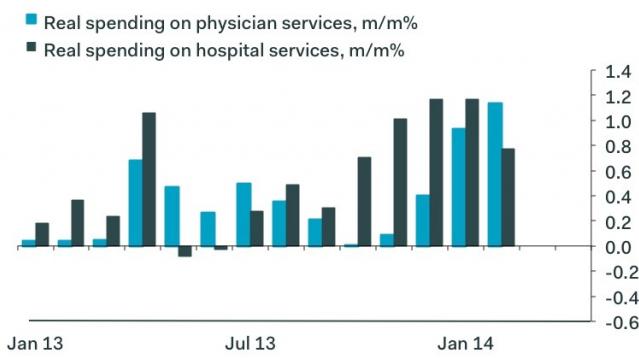Health care spending grew at the fastest rate in three decades in the first quarter of the year, boosting GDP growth by 1.1 percentage points — enough to lift the overall economy from contraction to modest 0.1 percent expansion.
The Bureau of Economic Analysis (BEA) said Wednesday that health care spending grew by 9.9 percent — the fastest surge since the third quarter of 1980, when spending on health care shot up by 10 percent.
Related: The Truth About Rising Health Care Costs
In a note accompanying the data release, the BEA said the jump reflected “additional spending associated with the implementation of the Affordable Care Act.” The agency noted, though, that because the preliminary data used in preparing the GDP report did not reflect the effects of Obamacare, its estimates of health care spending were based on Medicaid benefits, enrollment data from the new insurance exchanges and other information. That means the data could be heavily revised in the next two months.
“Obamacare is boosting consumption,” Ian Shepherdson, the chief economist at Pantheon Macroeconomics, said in a note. “Sharply increased health care spending, presumably due to the opening of the insurance exchanges, gave a hefty boost to Q1 consumption.”
So far, under the law, more than 8 million people have signed up for coverage on the state or federal exchanges, and millions more have gained coverage through the law’s Medicaid expansion. Of course, about a million of those signed up in late March and the special two-week enrollment period in April, meaning the uptick in health spending may continue in the second quarter.
The White House was quick to note that while health care spending jumped, the growth in health care prices has been much tamer, at 0.9 percent year over year.
“Ensuring access to care is a key goal of the Affordable Care Act’s coverage expansion, so this increase in utilization is neither a surprise, nor a cause for concern,” Jason Furman, chairman of the Council of Economic Advisers, wrote in a post on the White House blog. “Furthermore, any upward pressure on health care spending growth from expanding insurance coverage will cease once coverage stabilizes at its new, higher level, so it does not affect the longer-term outlook for spending growth.”
Shepherdson noted that overall consumption rose at a 3.0 percent rate, but nearly half of it was due to the leap in health care spending. (Spending on housing and utilities added 0.7 percentage points to GDP, as Americans spent more to heat their homes during the frigid winter months.)
Related: Recession Keeps Health Care Spending in Check
“The detailed consumption data for Jan/Feb show spending on both doctors and hospital services, which dominate the health care services component of GDP, began to accelerate rapidly last fall,” Shepherdson said. “Both are now running at more than twice their pre-Obamacare trend, indicating that pent-up/hidden demand or health care was huge. Next question: How long will it last?”
Health care spending rose throughout 2013 but jumped a more dramatic 5.6 percent in the fourth quarter of last year, which at the time represented the fastest rate since 2004.
Top Reads from The Fiscal Times:






